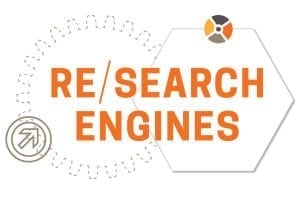Curiosity is creating an audible buzz among students and faculty engaged in DMU’s increasingly robust research enterprise. This story is part of “Research Engines,” a series on the questions being asked and investigated by DMU researchers.
Robert Clements is a certified personal trainer. Lara Terry was an undergraduate biochemistry, cell and molecular biology major with the goal of becoming a physician. Misty Carder worked as a certified pharmacy technician. Ronald Smith was a biochemist who also worked in sales.

“DMU has a collaborative environment with numerous health professionals training in the same place. It’s neat how students interact across programs,” says Clements, who’s researching specific G protein-coupled receptors and their role in cardiovascular disease following menopause, working in the lab of Kim Tran, M.D., Ph.D., associate professor of physiology and pharmacology. “It’s a great learning opportunity. I like that we get to choose our labs.”
DMU’s osteopathic and podiatric medical students also can complete the M.S. as a dual degree by devoting an extra year to research between the second and third years of their clinical program.
“These dual-degree students set themselves apart when they acquire extensive research experience and enhance their problem-solving skills,” says Suzanne Bohlson, Ph.D., associate professor of microbiology and immunology and director of the M.S.B.S. program.
Students in the 50-credit-hour M.S.B.S. program, which graduated its first students in 2009, select a faculty laboratory in their first year while completing most of their course work. They then conduct bench research in the selected lab and write and defend a thesis. Designed to prepare students to continue in biomedical research, pursue professional health care degrees, enter doctoral programs or teach at the college level, the program offers several advantages.

“One of the biggest selling points is that students benefit from one-to-one attention from diverse faculty who are asking questions in biomedical sciences that have a direct connection to human health,” Bohlson says. “Our students also sit side by side with osteopathic and podiatric medical students. That lets them see whether they want to continue in research or take the clinical route.”
In addition, the program attracts faculty who are eager to engage students in their research. “The students not only contribute to the research, but they also help keep us motivated,” she says. “There’s nothing like an enthusiastic student to keep the questions coming.”
The program has had good outcomes: Of the 20 graduates who did not go on to pursue a health care degree, just over half are in clinical research; one-quarter work in academic programs as laboratory technicians or Ph.D. candidates; and the rest work in industry. “There’s good demand for students coming out of our program,” Bohlson says.
Ashley Yingst landed a position in the pediatric oncology department at the University of Minnesota when she was just beginning to write her M.S.B.S. thesis. At DMU, she worked in the laboratory of Timothy Steele, Ph.D., microbiology and immunology program chair, in which she investigated — among other areas — the role that protein prenylation has on the proliferation of an aggressive natural killer cell leukemia, which is resistant to traditional chemotherapy.
“My biggest take-home from DMU was the ability to think critically. When something happens in the lab, you have to think of 50,000 reasons why and then design experiments to test them,” says Yingst, the M.S.B.S. program’s 2015 Graduate with Distinction. Now a research scientist III at the University of Minnesota, she is exploring whether the stem cell source — from umbilical cord blood or bone marrow — alters subsequent development of metabolic syndrome among children who undergo cancer therapy, and whether a donor’s inflammatory state alters the recipient’s likelihood of survival and post-transplant symptoms.
“Most of the principal investigators [at the University of Minnesota] are physicians, so we do a lot of research on patient samples,” she says. “That means we can have an impact on actual treatment.”
Jillissa Molnari wanted a career with the Division of Criminal Investigation of the Iowa Department of Public Safety after she toured its new laboratory in 2006. She reached that goal six months before completing her M.S. degree, joining the division’s toxicology laboratory as a forensic science technician in February 2015.
“I chose the M.S.B.S. degree at DMU because of the program’s close ties with the medical field,” she says. “I knew what my long-term goals were, and I knew the course work that is taught alongside medical students would get me the education I needed.”
As a DMU student working in the lab of Jeffrey Gray, Ph.D., a microbiologist and vice president for research, Molnari explored mechanisms to reduce or abolish the growth of Staphylococcus aureus. One of the five most common causes of infection after injury or surgery, the bacteria can cause heart, lung and brain infections, sepsis and other serious complications. She became interested in S. aureus for a personal reason: a childhood friend suffered from toxic shock syndrome due to the bacteria, which led to multi-organ failure, a hypoxic ischemic stroke and a lifelong brain injury.

“I know firsthand how devastating the outcome of an S. aureus infection can be,” she says. “I hope that the next students working in Dr. Gray’s lab are able to continue working on the multitude of questions my research has brought up.”
M.S.B.S. students build on past researchers’ work and know they eventually will hand off their own investigations to the next class. They’re perfectly okay with that. Vahe Matnishian, like Clements, is researching specific G protein-coupled receptors that have a potential role in hormone replacement therapy.
“This is an important field. The receptor I’m researching is not in therapeutic use yet, but it will be a game-changer in treatment,” Matnishian says. “It’s cool that I played a role in development of drugs that might be on the market in the next 10 years.”

